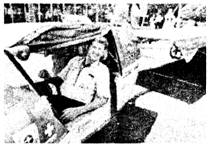题目内容
He had already walked three or four miles ________ he saw a cart, half-full of hay, by the side of the road.
A. when B. while C. until D. unless

 孟建平小学滚动测试系列答案
孟建平小学滚动测试系列答案I can't swim because I have a strongly fear of water. | 56. |
Looking hack my childhood experience, I think that | 57. |
three reasons might explain to the fear. The first is | 58. |
that I was not allowed to go near the water because | 59. |
my mother had a unreasonable fear of it. As a child | 60. |
I was teaching to see the water as something dangerous | 61. |
Second, my eyes became bad at five. If I took out my | 62. |
glasses in the water, I couldn't see anything, but this | 63. |
increased my fear. The worst is this as a child I saw | 64. |
a neighbor drown. Since then I've more frightened. | 65. |
In 1947 the pilot of a small aeroplane saw nine strange objects in the sky over
Since then, all over the world, people have 23 seeing similar strange objects. No one knows 24 they are or where they come from. Some people say that they do not 25 , but many others say that they have seen them. Usually people on the ground have seen them 26 not always. Airline 27 also have reported seeing them and so have 28 ── the men who fly in spaceships.
Perhaps some people saw them only in their 29 . Perhaps some people made a mistake. But airline pilots and astronauts do not usually make 30 of this kind. Captain Ed Mitchell, who was the sixth man to 31 on the moon, said in 1974 that he believes that some "flying saucers" are 32 . Many other people now believe that these 33 flying objects are visiting the 34 from other worlds in space.
The American government 35 to find out more about these objects. It listened to a great many people who said they had 36 them. But the Government Committee could not decide on what the objects were. It called them UFOs, which is 37 for "Unidentified Flying Objects".
In 1964, a driver of a police car in
There are many other 40 stories. Some are probably untrue but some may be true. No one knows.
21. A. spaceships | B. objects | C. saucers | D. planes |
22. A. topic | B. headline | C. passage | D. advertisement |
23. A. said | B. claimed | C. reported | D. announced |
24. A. what | B. who | C. why | D. which |
25. A. circle | B. understand | C. believe | D. exist |
26. A. still | B. but | C. and | D. or |
27. A. drivers | B. passengers | C. riders | D. pilots |
28. A. astronauts | B. scientists | C. officials | D. flyers |
29. A. creativity | B. imagination | C. mind | D. eyes |
30. A. troubles | B. changes | C. suggestions | D. mistakes |
31. A. walk | B. live | C. train | D. plough |
32. A. true | B. important | C. real | D. big |
33. A. ordinary | B. curious | C. strange | D. familiar |
34. A. ground | B. earth | C. land | D. people |
35. A. managed | B. succeeded | C. tried | D. persuaded |
36. A. seen | B. created | C. caught | D. entered |
37. A. good | B. long | C. fit | D. short |
38. A. coming | B. sitting | C. lying | D. standing |
39. A. rushed | B. flew | C. went | D. ran |
40. A. fiction | B. different | C. similar | D. frustrating |
 Swiss national Louis Palmer realized a childhood dream when he set off from his home country on July 3, 2007 traveling over desert, city and sea in 17 countries by a “solar taxi” to reach UN Climate Change Conference in
Swiss national Louis Palmer realized a childhood dream when he set off from his home country on July 3, 2007 traveling over desert, city and sea in 17 countries by a “solar taxi” to reach UN Climate Change Conference in